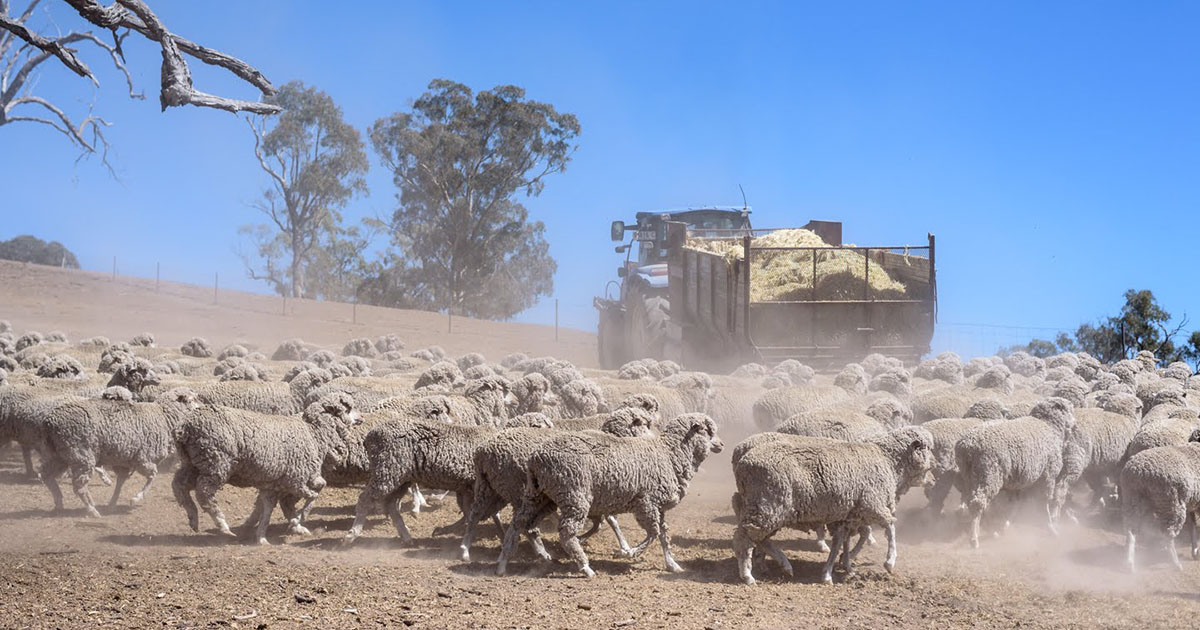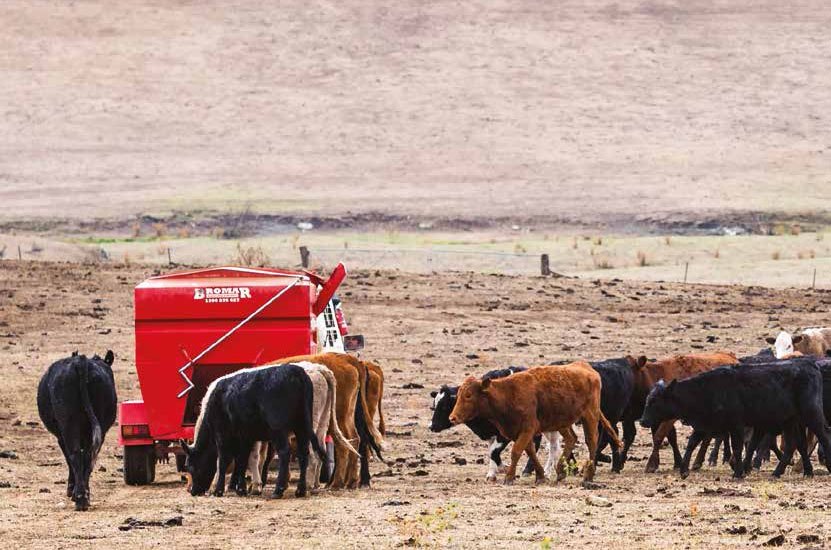Drought feeding livestock
How you feed your livestock through drought is a crucial decision. Doing a feed budget to understand your options in advance is a good drought management strategy.
The amount and type of feeding required will depend on the quality of the feed (energy and protein levels), the size, type, condition, stage of pregnancy or lactation of livestock, what facilities or equipment are available, past feeding history of livestock, and the degree that livestock have been affected by drought.
Drought affected pastures deteriorate in both quality and quantity (kilograms of dry matter per hectare, or kg DM/ha). Once digestibility of dry feed falls below 55% stock will start to lose weight, regardless of how much is in front of them. When dry feed becomes limiting, energy requirements can then be met by feeding out cereal grains and/or hay.
However, dry standing feed is a valuable resource and should be utilised. If you are unsure about the quality of your dry feed, it is recommended that you send a pasture sample away for feed quality testing.
When comparing different types of feed, it is useful to consider their cost-effectiveness. Our guide to balancing cost vs nutrition of livestock feed can help.

Drought feeding sheep
- Lactating ewes need at least 20% hay to maintain milk production
- Rapidly growing sheep and lambs, ewes in late pregnancy and lactation have higher requirements for energy and protein.
- A protein supplement will be required in some situations for growth and maintenance.
- It would be best if lambs are fed for production.
- Before introducing grain, introduce hay first to minimise acidosis.
Fat scoring to assess ewe condition enables you to fine-tune your feeding program. Ewes at fat score 3 will have minimal feed requirements as they can simply be maintained at this level. Ewes below fat score 2.5 have an increased risk of being dry. These ewes can be drafted off and allocated to better paddocks or supplementary fed to aid in joining.
The table below indicates how much feed sheep need based on breeding condition and mixed feed combinations.
Sheep feed options as minimum weight (kg) per day 'as fed':
| Stock Type | Grain only (12ME) | Hay only (8.5ME) | 50:50 Grain : Hay | 80:20 Grain : Hay | Silage (35% dry matter 9ME) | Expected weight gain/day |
|---|---|---|---|---|---|---|
| Weaner (20kg) | 0.62 | 1.08 | 0.80 | 0.68 | 2.54 | 0.1 kg |
| Weaner (30kg) | 0.76 | 1.32 | 0.98 | 0.84 | 3.09 | 0.1 kg |
| Adult dry stock (50kg) | 0.65 | 0.99 | 0.79 | 0.7 | 2.37 | Nil |
| Ewes, last 6 weeks of pregnancy (50kg) | 1.1 | 1.68 | 1.33 | 1.18 | 4.02 | Nil |
| Ewe and lamb to one month (50kg) | Not suitable | 2.46 | 1.96 | 1.74 | 5.91 | Nil |
| Ewe and lamb to 2-3 months (50kg) | Not suitable | 1.77 | 1.41 | 1.25 | 4.26 | Nil |
Read about general ewe nutrition to understand average feed requirements.

Drought feeding cattle
- Lactating cows need at least 20% hay to maintain milk production.
- Young cattle need a minimum level of 9% protein for growth.
- It would be best if young cattle are fed for production.
- Before introducing grain introduce hay first to minimise acidosis.
The table below indicates how much feed cattle need based on breeding condition and mixed feed combinations.
Cattle feed options as minimum weight (kg) per day 'as fed':
| Stock Type | Grain only (12ME) | Hay only (8.5ME) | 50:50 Grain : Hay | 80:20 Grain : Hay | Silage (35% dry matter 9ME) | Expected weight gain/day |
|---|---|---|---|---|---|---|
| Weaner (250kg) | 3.5 | 5.5 | 4.5 | 4 | 14 | 0.25 kg |
| Yearling (330kg) | 4.4 | 7 | 5.5 | 4.8 | 16.8 | 0.25 kg |
| Adult dry stock (500kg) | 5 | 7.8 | 6.2 | 5.5 | 18.6 | Nil |
| Breeder, late pregnancy (500kg) | 6.1 | 9.3 | 7.4 | 6.6 | 22.4 | Nil |
| Breeder, lactating (500kg) | Not suitable | 12.5 | 9.9 | 8.8 | 29.8 | Nil |
For further advice, the DPI Feed Cost Calculator calculates and prepares protein, energy and other components for different mixes of livestock feeds.
Tips for drought feeding livestock
Things to remember:
- Acidosis (grain poisoning) is the biggest killer of sheep being confined and fed concentrates. It is important to introduce grain gradually over a few weeks. Be careful transitioning from one grain to another (for example, barley to wheat where you are increasing the starch content). Also take care when transitioning from one batch of feed to another (even if they are the same product) as variations do occur. Shandying the old and new feeds can help reduce acidosis risk as can the addition of rumen buffers to the ration.
- Remember that grain is generally low in calcium and high in phosphorus so we need to provide supplementary calcium in the ration (usually in the form of stock lime). This is particularly important for late pregnant/lactating ewes and young growing stock to avoid hypocalcaemia.
- Vitamins A and E can become deficient in stock where there has been no access to green feed for over 6 months.
- When feeding cereal grains it is important to add 1 - 1.5% agricultural limestone and 0.5 - 1% salt to prevent calcium deficiencies.
- If you have the space and the infrastructure to feed in a confined lot, seek advice on what you need for confinement feeding based on the amount of stock.
Tips for supplementary feeding hay
The quality of your hay will have a significant impact on the grains and supplements you choose to feed.
Appearance is a poor indicator of the nutritive value of hay. Even grass hays that appear very similar can vary in protein content by two to three times. You can do a feed test on the hay to ensure you are meeting your livestock’s nutritive needs.
- Break open a hay bale or dig into the bale, get a good sample and scratch ‘n’ sniff. Hay of a sweet and pleasant smell will tend to have higher quality than hay with little or no smell. Hay with a dirt type smell is generally of very poor quality.
- Good quality hay should be green rather than yellow or brown. Keep in mind that some hays, particularly some varieties of clover, can cure to quite a dark colour.
- Hay should have a high leaf content for higher quality. Leaf is more digestible than stem and stalk (“stemmy” hay is likely to be low in digestibility). Hays with large amounts of seed heads shows that it has been cut quite late and will be of lower quality.
- A sample of the hay when taken in both hands should be easy to break apart (this is a sign of good quality hay), it should not hurt your hands when you squeeze it, if it does it has been cut too late and will be of low nutrient content.
- Check your hay sample for awns. This can sometimes be an issue when feeding to stock and makes these hays unsuitable for processing and inclusion in feed mixes.
- There should be no visible mould (white or dark, matted patches in the hay) or other foreign material like dirt or sand. When opening hay look for dust as this can be an issue when feeding and is not desirable for confined feeding situations.
- Be aware of weed seed. Find out where your hay has come from if bringing it in. Most times it is extremely hard to find some weed seeds in hay. Try to feed your hay in only a few locations and locations where you have easy access and visit frequently so that you are able to control any new and unusual plants.
- When feeding, avoid overhead hay racks as dust from the hay falling into eyes and face can cause health issues.
This information is also available to download in the LLS Drought Handbook PDF, 1191.96 KB.